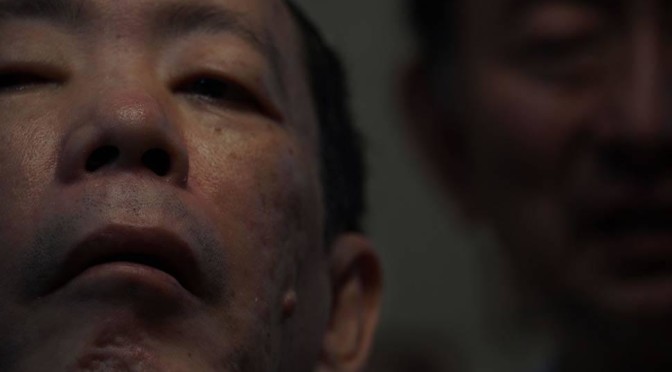Cannibalism has always been a horror story in the sense that it provokes both disgust and fascination. In colonial history and legends from the greek to the slavic it has served to separate the human from the inhuman, the civilized from the primitive. And at this point ‚Caniba‘ starts, a documentary by Verena Paravel and Lucien Castaing-Taylor, who work as both anthropologists and filmmakers. It puts the viewer uncomfortably close to the questions: What can we know about cannibalistic desire? What do cannibals dream of at night?
The films protagonist is Issei Sagawa, who murdered and ate his fellow student Renee Hartevelt in 1981. He was immediately caught and put on trial only to be declared insane. Today he lives with his brother Jun in Japan, suffering from diabetes and the effects of a stroke he had several years ago. We see Issei and his brother, talking quietly and in between long pauses. It is not exactly clear where they are, because the documentary is shot in ultra close up. These choices will make up a big part of what this movie is about: The camera is focusing or in some cases purposely unfocusing on the faces of the protagonist and his brother. The space around them is only related through the sounds, creating a room of disoriantation and intimacy. Flesh and skin fill the screen most of the time. The protagonists mouth features prominently, moving the viewer to think about what that mouth has touched, chewed and swallowed before. The dissolution of the faces when the camera unfocuses makes them an undefined mass of flesh-coloured material. In this and the continuous focus on the faces it also asks the question of what we can or cannot read out of a face and how being reconigzable is a part of responsibility for your desires and your deeds.
Even though the film explicitly states that it doesn’t want to legitimize the crime, it wants the viewer to be uncomfortably close to it’s protagonist and reflect on the shape and nature of human desire. There is a homemade porno shown, featuring Issei and a female partner, the next scene focuses on a manga, where the protagonist has drawn the cannibalistic murder in explicit detail. Putting the scenes right next to each other inevitably opens up a space for comparison between your own desires and the desires of this man, who has done something that seems utterly against humanity. In a sequence of homevideos from the 50s you see the two brothers as children playing and dancing around the house. This opens up a message for the viewer: The borders are fleeting and not set in stone; the difference between desires is measured as a spectrum. The comparison is most importantly reflected on the screen as the protagonists brother Jun is seen both judging and empathising with his brother. This relationship between the two is strange and confusing until Jun reveals his own masochistic desires to his brother. They of course seem tame, which they really aren’t, but in comparison to sexual cannibalism, suddenly they are. Jun is searching for some judgement from his brother. Issei doesn’t answer. Later Jun also asks: „Does it have to be a woman? Would you also eat a man? Would you eat me?“ This question too, remains unanswered for the viewer.
‚Caniba‘ manages to articulate the complexity of dealing with something like cannibalism without presenting Issei Sagawa as inhuman and still retaining a distance to him. In some parts it is hard to watch, but the scene where Jun shows videos of his masochistic practices is entirely in service to the subject. Existential, many-layered and profoundly conscious of it’s form, it merges style and subject matter into an amazing documentary.
The picture for this article is from the Website of La Biennale di Venezia and doesn’t belong to the author.

